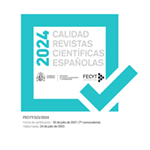Bioarchaeological Contributions to the Study of Colonial Urban Populations in South America (Mendoza, Argentina)
Abstract
In this paper we give the results of the analysis of human skeletal remains recovered by archaeological excavations carried out in 2009 by the Center for Research Ruins of San Francisco in San Francisco Temple, located in the north of Mendoza. The sector excavated R corresponds to the pilaster at the entrance of the temple of the eighteenth century, covering both the exterior and interior of the area. Bioanthropological and taphonomic results corresponding to six individuals from the whole bone. The chronology of each individual according to their position in space and burial context is also defined. These studies contribute to the characterization of the health and nutrition of urban historical population in the city of Mendoza.Downloads
Article download
License
In order to support the global exchange of knowledge, the journal Revista Española de Antropología Americana is allowing unrestricted access to its content as from its publication in this electronic edition, and as such it is an open-access journal. The originals published in this journal are the property of the Complutense University of Madrid and any reproduction thereof in full or in part must cite the source. All content is distributed under a Creative Commons Attribution 4.0 use and distribution licence (CC BY 4.0). This circumstance must be expressly stated in these terms where necessary. You can view the summary and the complete legal text of the licence.









